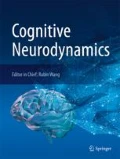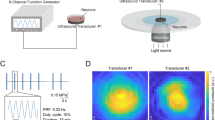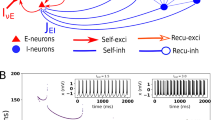Abstract
It has been found that gamma oscillations and the oscillation frequencies are regulated by the properties of external stimuli in many biology experimental researches. To unveil the underlying mechanism, firstly, we reproduced the experimental observations in an excitatory/inhibitory (E/I) neuronal network that the oscillation became stronger and moved to a higher frequency band (gamma band) with the increasing of the input difference between E/I neurons. Secondly, we found that gamma oscillation was induced by the unbalance between positive and negative synaptic currents, which was caused by the input difference between E/I neurons. When this input difference became greater, there would be a stronger gamma oscillation (i.e., a higher peak power in the power spectrum of the population activity of neurons). Further investigation revealed that the frequency dependency of gamma oscillation on the input difference between E/I neurons could be explained by the well-known mechanisms of inter-neuron-gamma (ING) and pyramidal-interneuron-gamma (PING). Finally, we derived mathematical analysis to verify the mechanism of frequency regulations and the results were consistent with the simulation results. The results of this paper provide a possible mechanism for the external stimuli-regulated gamma oscillations.










Similar content being viewed by others
References
Adjamian P, Hadjipapas A, Barnes GR et al (2008) Induced gamma activity in primary visual cortex is related to luminance and not color contrast: an MEG study. J Vis 8(7):1–7
Araki O, Tsuruoka Y, Urakawa T (2020) A neural network model for exogenous perceptual alternations of the Necker cube. Cogn Neurodyn 14(11):229–237
Bartos M, Vida I, Jonas P (2007) Synaptic mechanisms of synchronized gamma oscillations in inhibitory interneuron networks. Nat Rev Neurosci 8(1):45–56
Brunel N, Wang XJ (2003) What determines the frequency of fast network oscillations with irregular neural discharges? J Neurophysiol 90:415–430
Burns SP, Xing D, Shapley RM (2011) Is gamma-band activity in the local field potential of V1 cortex a ‘clock’ or filtered noise? J Neurosci 31(26):9658–9664
Dayan P, Abbott LF (2001) Theoretical neuroscience: computational and mathematical modeling of neural systems. MIT Press, Cambridge
Henrie J, Shapley R (2005) LFP power spectra in V1 cortex: the graded effect of stimulus contrast. J Neurophysiol 94:479–490
Hipp JF, Engel AK, Siegel M (2011) Oscillatory synchronization in large-scale cortical networks predicts perception. Neuron 69(2):387–396
Jadi MP, Sejnowski TJ (2014a) Cortical oscillations arise from contextual interactions that regulate sparse coding. Proc Natl Acad Sci 111(18):6780–6785
Jadi MP, Sejnowski TJ (2014b) Regulating cortical oscillations in an inhibition-stabilized network. Proc IEEE 102(5):830–842
Kim S, Lim W (2018) Effect of spike-timing-dependent plasticity on stochastic burst synchronization in a scale-free neuronal network. Cogn Neurodyn 12(3):315–342
Kim S, Lim W (2020) Effect of interpopulation spike-timing-dependent plasticity on synchronized rhythms in neuronal networks with inhibitory and excitatory populations. Cogn Neurodyn. https://doi.org/10.1007/s11571-020-09580-y
Malagarriga D, Pons AJ, Villa AEP (2019) Complex temporal patterns processing by a neural mass model of a cortical column. Cogn Neurodyn 13:379–392
Neymotin SA, Lee H, Park E, Fenton AA et al (2011) Emergence of physiological oscillation frequencies in a computer model of neocortex. Front Comput Neurosci 5:19
Orekhova EV, Butorina AV, Sysoeva OV et al (2015) Frequency of gamma oscillations in humans is modulated by velocity of visual motion. J Neurophysiol 114(1):244–255
Perry G, Randle JM, Koelewijn L et al (2015) Linear tuning of gamma amplitude and frequency to luminance contrast: evidence from a continuous mapping paradigm. PLoS ONE 10(4):e0124798
Ray S, Maunsell JH (2010) Differences in gamma frequencies across visual cortex restrict their possible use in computation. Neuron 67(5):885–896
Ray S, Maunsell JH (2011) Different origins of gamma rhythm and high-gamma activity in macaque visual cortex. PLoS Biol 9(4):e1000610
Sacerdote L, Giraudo MT (2013) Stochastic integrate and fire models: a review on mathematical methods and their applications. Quant Biol 2058:99–148
Saleem AB, Lien AD, Krumin M et al (2017) Subcortical source and modulation of the narrowband gamma oscillation in mouse visual cortex. Neuron 93(2):315–322
Tiesinga P, Sejnowski TJ (2009) Cortical enlightenment: are attentional gamma oscillations driven by ING or PING? Neuron 63(6):727–732
Vida I, Bartos M, Jonas P (2006) Shunting inhibition improves robustness of gamma oscillations in hippocampal interneuron networks by homogenizing firing rates. Neuron 49(1):107–117
Wallace E, Benayoun M, Drongelen WV et al (2011) Emergent oscillations in networks of stochastic spiking neurons. PLoS ONE 6:e14804
Wang XJ, Buzsáki G (1996) Gamma oscillation by synaptic inhibition in hippocampal interneuronal network model. J Neurosci 16(20):6402–6413
Acknowledgements
This work was supported by the National Natural Science Foundation of China (Grants Nos. 11972115, 11572084), Shanghai Municipal Science and Technology Major Project (No. 2018SHZDZX01), Key Laboratory of Computational Neuroscience and Brain-Inspired Intelligence (LCNBI) and ZJLab.
Author information
Authors and Affiliations
Corresponding authors
Additional information
Publisher's Note
Springer Nature remains neutral with regard to jurisdictional claims in published maps and institutional affiliations.
Rights and permissions
About this article
Cite this article
Gu, X., Han, F. & Wang, Z. Dependency analysis of frequency and strength of gamma oscillations on input difference between excitatory and inhibitory neurons. Cogn Neurodyn 15, 501–515 (2021). https://doi.org/10.1007/s11571-020-09622-5
Received:
Revised:
Accepted:
Published:
Issue Date:
DOI: https://doi.org/10.1007/s11571-020-09622-5




